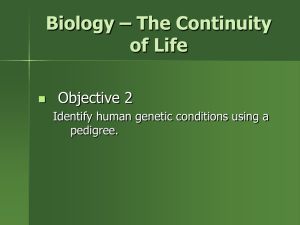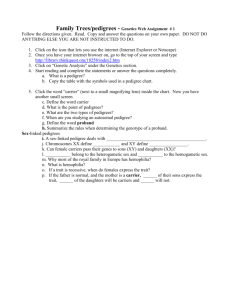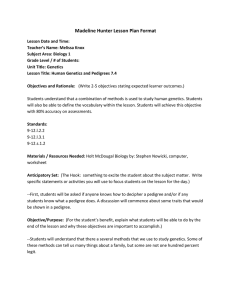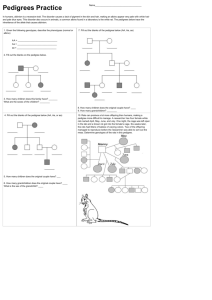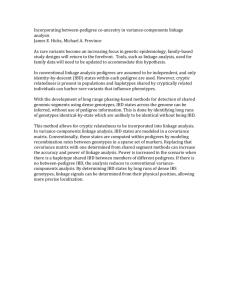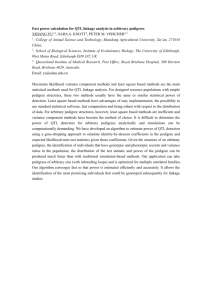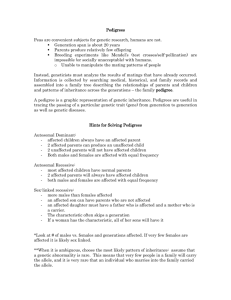How far back can we go? Examples and conclusions.
advertisement
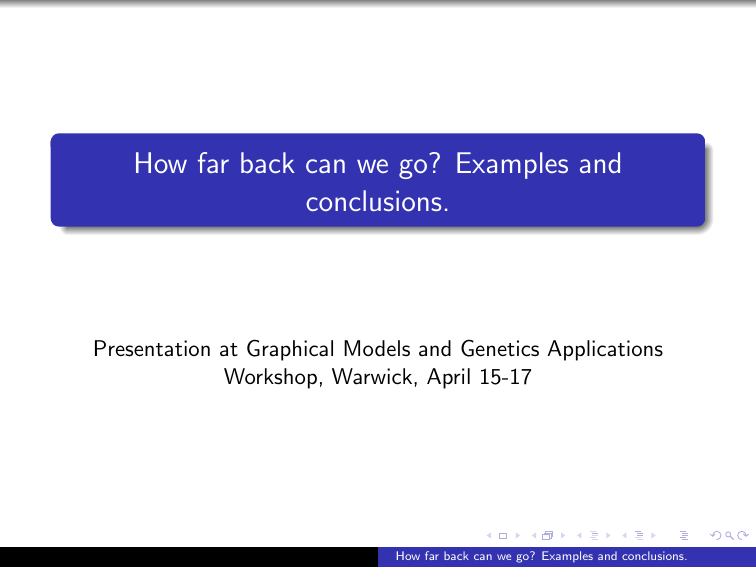
How far back can we go? Examples and conclusions. Presentation at Graphical Models and Genetics Applications Workshop, Warwick, April 15-17 How far back can we go? Examples and conclusions. FEST: R-package for computing likelihoods for hypothesized family relations Linked autosomal SNP markers Restrict attention to pairwise relations: Likelihoods and posterior probabilities for specific alternative family relations. Provides a front-end to MERLIN which do the actual likelihood computations. (Lander-Green algorithm) May specify any possible family relation under certain constraints (no inbreeding loops, very distant family relations cause computational problems) How far back can we go? Examples and conclusions. Extended pairwise family relationships Half-sib relations. One common ancestor. (Jefferson example) HS-n1 -n2 : n1 generations between common ancestor and A, n2 generations between the ancestor and B. Sibling relations. Two common ancestors. S-n1 -n2 : n1 generations between common ancestors and A, n2 generations between the ancestors and B. Parent-child relations. Person A is the ancestor of person B. PC-n: n generations between A and B. HS−2−2 S−1−2 PC−2 A A A B B B How far back can we go? Examples and conclusions. IBD probabilities for different numbers of IBD alleles and pairwise family relationships IBD 0 1 2 HS-n1 -n2 n1 +n2 −1 1 − 12 1 n1 +n2 −1 2 0 1 S-n1 -n2 1 n1 +n2 −2 − 2 − 14 1(n1 = n2 = 1) 1 n1 +n2 −2 − 12 1(n1 = n2 = 1) 2 1 4 1(n1 = n2 = 1) PC-n n−1 1 − 12 1 n−1 2 0 Note that for HS-1-1, S-1-2 and PC-2 the probabilities are 0.5, 0.5 and 0 for IBD = 0, 1 and respectively (example shown by Thore). How far back can we go? Examples and conclusions. Example: Checking family relationships prior to linkage or association studies Linkage study on autosomal dominant epilepsy Data from 3722 SNPs on 22 autosomal chromosomes Posterior probabilities computed for each supposed each true (corresponding to columns) and hypothesised family relation. Flat prior relation S-1-1 HS-1-1 S-2-2 S-3-3 S-1-1 1.000 0.000 0.000 0.000 HS-1-1 0.000 1.000 0.000 0.000 S-2-2 0.000 0.000 1.000 0.001 S-3-3 0.000 0.000 0.000 0.974 Unrelated 0.000 0.000 0.000 0.025 How far back can we go? Examples and conclusions. Example: Checking relationships between founders A recessive disease. Are the founders related? Data from 3439 SNPs on 22 autosomal chromosomes Posterior probabilities computed for each founder pair and hypothesised family relationship. Flat prior Founder pair 1 Founder pair 2 Founder pair 3 S-2-2 0.000 0.000 0.987 S-3-3 0.001 0.001 0.000 HS-2-2 0.000 0.000 0.013 HS-3-3 0.034 0.028 0.000 Unrelated 0.965 0.972 0.000 How far back can we go? Examples and conclusions. Example. How far back can you go from a genome-wide scan? Simulate data on a pair of individuals for six extended half-sib pedigrees Compute average posterior probabilities of that true relationship versus the hypothesis that they are unrelated. Based on Affymetrix 500K frequency data and genetic map data. Posterior probabilities IBD prob. share 1 allele 22 unlinked markers 220 linked markers 2200 linked markers 22 000 linked markers Affymetrix 500 K HS-1-1 1/2 0.633 0.943 1.000 1.000 1.000 HS-2-2 1/8 0.514 0.594 0.942 1.000 1.000 HS-3-3 1/32 0.501 0.507 0.617 0.950 1.000 HS-4-4 1/128 0.500 0.500 0.514 0.706 0.848 HS-5-5 1/512 0.500 0.500 0.502 0.558 0.642 HS-6-6 1/2024 0.500 0.500 0.501 0.509 0.531 How far back can we go? Examples and conclusions. Example (cont): How far back can you go from a genome-wide scan? A second simulation study used the same Affymetrix data and genetic map, but now comparison with closer alternatives are considered. Specifically, data are simulated for each of the HS-1-1, HS-2-2, ..., HS-5-5 relationships and compared against all five options in addition to the unrelated case. True family relation HS-1-1 HS-2-2 HS-3-3 HS-4-4 HS-5-5 Unrelated HS-1-1 1.000 0.000 0.000 0.000 0.000 0.000 HS-2-2 0.000 0.952 0.039 0.000 0.000 0.000 HS-3-3 0.000 0.048 0.750 0.161 0.024 0.002 HS-4-4 0.000 0.000 0.182 0.450 0.275 0.090 HS-5-5 0.000 0.000 0.029 0.287 0.376 0.327 Unrel 0.000 0.000 0.000 0.102 0.325 0.581 How far back can we go? Examples and conclusions. Conclusions: How far back can you go from a genome-wide scan? If we consider extended half-sib relationships versus the unrelated alternative, previous example shows HS-3-3 can be clearly distinguished from unrelated. (number of meiosis = 6) HS-4-4 can be determined with reasonable certainty. (number of meiosis = 8) More distant relationships, corresponding to number of meiosis > 8, seem to be outside the scale of what is possible with 500K markers. How far back can we go? Examples and conclusions. Graphs and pedigrees: Pedigrees are often represented graphically but not necessarily as graphs. A standard representation of a pedigree (squares for males, circles for females): A B How far back can we go? Examples and conclusions. Graphs representations of pedigrees Many possible graph representations of pedigrees: relationship graphs, marriage node graphs, segregation network, ... Pedigree graphs are DAGs. Have natural ordering whereby parents precede offspring. Pedigrees can have undirected cycles due to inbreeding. How far back can we go? Examples and conclusions. Bayesian network and pedigrees A pedigree may be represented in form of a Bayesian network that is a DAG satisfying the directed Markov property: p(x) = K Y p(xi |xpa(i) ) i=1 where pa(i) are the parents of node i. Bayesian network representations of a pedigree: Segregation network: contains all details of the inheritance of the two alleles from the parents to the offspring. Genotype network: Each node corresponds to an individual. The Markov property holds under the Mendelian inheritance model. The joint probability distribution of the genotype configuration of the pedigree may then be written as Y Y p(g) = p(gi ) p(gj |gMj , gFj ) founders i non-founders j How far back can we go? Examples and conclusions.
